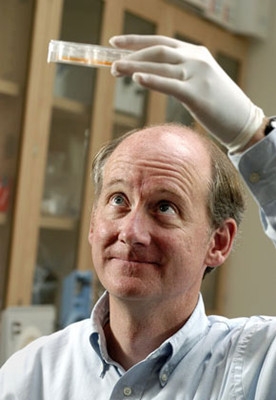科學(xué)技術(shù)
The uses of stem cells
干細(xì)胞的應(yīng)用
Potent medicine
特效醫(yī)學(xué)
Stem cells may transform the development of new drugs
干細(xì)胞可能改寫新藥發(fā)展
PLURIPOTENT is a long word that means able to do many things.
多能的意思是能做很多事。
It is the technical term applied to stem cells that can generate many different sorts of bodily tissue, rather than just one sort, which is all that lesser stem cells can manage.
這一技術(shù)術(shù)語適用于可分化成多種不同身體組織的干細(xì)胞,而不是像次級(jí)分化干細(xì)胞一樣只可以分化成一種身體組織。
But many researchers hope these cells will be pluripotent in other ways, too.
但是研究者希望干細(xì)胞在其他方面也具備多能性。
 Not only might they be used to make replacement tissues and organs for transplantation into those whose existing body parts no longer work properly, they might also be used to produce pure cultures of cells for the early testing of drugs.
Not only might they be used to make replacement tissues and organs for transplantation into those whose existing body parts no longer work properly, they might also be used to produce pure cultures of cells for the early testing of drugs.
干細(xì)胞不僅可用于獲得某些身體部分運(yùn)作不良者移植用的替換組織或器官,還可以用于培養(yǎng)藥物早期試驗(yàn)用的純系細(xì)胞。
The culturing and use of human pluripotent stem cells is controversial because the natural source of such cells is embryos, which are destroyed by the process of extraction.
人類多功能干細(xì)胞的培養(yǎng)和使用備受爭議,因?yàn)檫@類細(xì)胞的自然來源胚胎,在提取過程中會(huì)被破壞。
But in 2007 two groups of researchers, one in Japan and the other in America, announced that they had worked out how to make adult skin cells behave like natural pluripotent cells, by adding four activated genes to them.
但是2007年,日本和美國各有研究者表示,通過增加4個(gè)激活基因,成人皮膚細(xì)胞可有與自然多功能細(xì)胞相同的表現(xiàn)。
The result is known as an induced pluripotent stem cell.
這一成果被稱為誘導(dǎo)多功能干細(xì)胞。
On January 3rd AstraZeneca, a British drug company, said it would buy human heart muscle, blood vessels, nerve cells and liver cells made from iPS cells by Cellular Dynamics, a company founded by James Thomson.
1月3日,英國阿斯利康制藥表示將向杰姆·湯姆生創(chuàng)立的細(xì)胞動(dòng)力公司購買用誘導(dǎo)能干細(xì)胞生產(chǎn)的心肌、血管、神經(jīng)細(xì)胞和肝細(xì)胞。
Dr Thomson, a biologist at the University of Wisconsin, is the man who led the team that, in 1998, isolated the first human embryonic stem cells and in 2007 published the American version of the iPS work.
湯姆生博士是威斯康星大學(xué)的生物學(xué)家。他帶領(lǐng)的團(tuán)隊(duì)在1998年首次分離了人類胚胎干細(xì)胞,并在2007年發(fā)表美方的誘導(dǎo)能干工作成果。
AstraZeneca has two plans for its purchases.
阿斯利康這次的計(jì)劃有兩個(gè):
One is to use them to find molecules that encourage non-pluripotent stem cells to turn into mature tissue.
一是利用誘導(dǎo)能干細(xì)胞尋找能刺激非能干細(xì)胞轉(zhuǎn)化成成熟組織的分子。
Such molecules could act as drugs that coax damaged tissue to heal itself.
這類分子可作為誘導(dǎo)損傷組織自我修復(fù)的藥物;
The second is to use iPS cells to test drugs that have nothing to do with regenerative medicine.
二是利用誘導(dǎo)能干細(xì)胞測試與再生醫(yī)學(xué)無關(guān)的藥物。
Too often, a promising-looking drug fails late on in a clinical trial.
一個(gè)前景光明的藥物常常在之后的臨床試驗(yàn)中失敗。
Sometimes this is because it does not deliver the promised benefit.
有時(shí)是由于該藥未起到預(yù)期作用;
Sometimes, however, it works but its side effects prove more dangerous than the disease it is supposed to treat.
而有時(shí)藥物起作用了,但副作用比其治療的疾病更危險(xiǎn)。
The cost of failed trials is an important reason why drug research is so expensive.
試驗(yàn)花費(fèi)是藥物研究成本高昂的一個(gè)重要原因。
AstraZeneca therefore plans to use Cellular Dynamics's cells to check the toxicity of potential medicines before they get inside a human being, in order to reduce the number of trials that fail for the second reason.
所以阿斯利康計(jì)劃在人體試驗(yàn)前,利用細(xì)胞動(dòng)力公司的細(xì)胞來測試新藥的毒性,以便減少由第二個(gè)原因?qū)е碌脑囼?yàn)失敗。
And AstraZeneca is not the only company using iPS cells in new ways.
阿斯利康并不是唯一一家在新領(lǐng)域應(yīng)用誘導(dǎo)能干細(xì)胞的公司。
In December GlaxoSmithKline,another British firm, described an experiment in which it assaulted neurons derived from iPS cells with beta-amyloid, a molecule linked to Alzheimer's disease, and then tested whether the beta-amyloid responded to hundreds of existing drugs.
另一家英國公司葛蘭素史克11月公布了一項(xiàng)實(shí)驗(yàn):該實(shí)驗(yàn)利用帶β-淀粉的誘導(dǎo)能干細(xì)胞分化的神經(jīng)細(xì)胞來測試β-淀粉對(duì)成千上百種現(xiàn)有藥物的反應(yīng)。
The findings of this experiment will be published in Stem Cell Research in March.
實(shí)驗(yàn)結(jié)果將發(fā)表在3月份的《干細(xì)胞研究》上。
Another trick made possible by iPS cells is to derive them from patients with specific ailments—particularly ailments with a genetic component—and then nudge the induced cells into becoming the type of cell afflicted by that ailment.
誘導(dǎo)能干細(xì)胞還可實(shí)現(xiàn)另一種可能,即從患有特定疾病—尤其是與基因有關(guān)的疾病—的患者身上獲得誘導(dǎo)能干細(xì)胞,然后使其轉(zhuǎn)變成受該疾病影響的特定細(xì)胞。
Several groups of researchers have used disease-prone cells created in this way to explore how the disease in question develops, and whether it succumbs to drugs.
有幾個(gè)研究小組已利用這種疾病傾向細(xì)胞來探索疾病的發(fā)展及藥物的有效性。
George Daley, of Harvard University, is one of the most enthusiastic explorers of these disease in a dish models.
哈弗大學(xué)的喬治?戴利是最熱衷于這些皿中疾病的研究者之一。
In 2008 he created stem-cell lines from people with ten different conditions, including Down's syndrome, juvenile diabetes and Parkinson's disease.
2008年他從十種不同疾病—包括唐氏綜合征、青少年型糖尿病及帕金森病—的患者身上獲得干細(xì)胞株。
Such models are hardly foolproof—Dr Daley himself acknowledges that the technology is still in its infancy—but eventually they may bring new drugs.
這些模型難免存在差錯(cuò)—戴利博士也承這一技術(shù)還處于起步階段,但最終它們可能帶來新藥。
iPierian, a company that Dr Daley helped found, has used iPS cells to develop two antibodies that might be used to attack tau, a protein implicated in Alzheimer's disease, and also to clear up inflammation linked with Alzheimer's and other neurodegenerative conditions.
戴利參與創(chuàng)立的iPierian公司利用誘導(dǎo)能干細(xì)胞研制了兩種抗體。這兩種抗體或可用于攻擊與阿爾茲海默病有關(guān)tau蛋白,同事可能用于消除與阿爾茲海默病和其他神經(jīng)退化性疾病有關(guān)的炎癥。
That is a use far removed from the original idea of employing stem cells in regenerative medicine.
這與將干細(xì)胞應(yīng)用于再生醫(yī)學(xué)的原始想法相去甚遠(yuǎn)。
The plurality of their potency, then, is only just beginning to be explored.
干細(xì)胞多能性應(yīng)用多樣化的探索才剛剛起步。
 Not only might they be used to make replacement tissues and organs for transplantation into those whose existing body parts no longer work properly, they might also be used to produce pure cultures of cells for the early testing of drugs.
Not only might they be used to make replacement tissues and organs for transplantation into those whose existing body parts no longer work properly, they might also be used to produce pure cultures of cells for the early testing of drugs.










